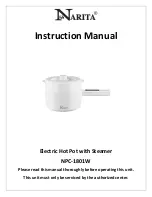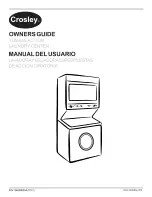
CARE AND MAINTENANCE
When not in use, store your pressure cooker in a dry place. To prevent unpleasant odors
from lingering, store the unit with the cover inverted on the cooker body.
As is the case with all cookware, avoid chopping or cutting food inside the cooking pot with
a knife or other sharp utensil. Do not use metal utensils as they may scratch the nonstick
surface.
The sealing ring and gasket for the air vent/cover lock may shrink, become hard, deformed,
cracked, or torn with normal use. When this happens, replace the sealing ring and/or the air
vent/cover lock gasket.
Leakage between the cover and cooker body is usually caused by deterioration of the sealing
ring after prolonged use.
Periodically check the vent pipe nut for looseness. If necessary, retighten with a ½ʺ wrench.
Occasionally
1. Remove the air vent/cover lock for cleaning. Place your finger over the top of the air vent/
cover lock on the cover (Fig. R) and remove the gasket from the underside of the cover (Fig.
S). Push the air vent/cover lock through the top of the cover. Wash it and the gasket in warm,
soapy water. The metal shaft may be cleaned with a nylon mesh pad. Clean the cover hole
with a small brush. After cleaning, reinsert the metal shaft from the top side of the cover
down through the cover hole. Place a finger over the top of the air vent/cover lock and push
the gasket onto the end of the metal shaft, fitting it into the groove.
2. Remove the gasket on the sensor (Fig. T) and wash it in warm, soapy water. Clean the
sensor with a damp cloth and place the gasket back on the sensor.
3. Wipe the outside of the cooker body with a damp cloth.
HELPFUL TIPS
Use the cooking rack when it is desirable to cook foods out of the cooking liquid. When
foods are pressure cooked out of the liquid, flavors will not intermingle. Therefore, it is
possible to cook several foods at once, as long as they have similar cooking times. If it is
desirable to blend flavors, do not use the cooking rack.
Many different cooking liquids can be used in a pressure cooker. Wine, beer, broth, fruit
juices, and of course water all make excellent cooking liquids in the pressure cooker.
It is the size and shape of the food pieces, rather than the quantity, that affects
pressure cooking time. For example, 1 potato will have the same cooking time as 6 potatoes
of similar size. It is important to note the size of the food specified in the cooking
timetables; if the pieces of food being cooked are of a size different than those noted, it will
be necessary to adjust the cooking time.
SOAKING
Soaking before pressure cooking is strongly recommended for dry beans and peas, except lentils
and black-eyed peas. Benefits of soaking include eliminating some of the water soluble starches that
produce gas and create froth and foam during cooking, decreasing the cooking time, and producing
beans and peas that are more evenly cooked. Soaking can be done using the traditional or the quick-
soak method.
50











































